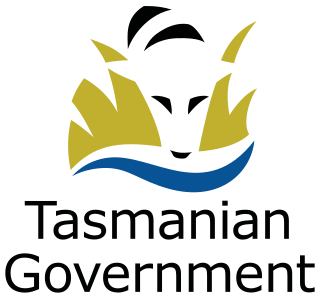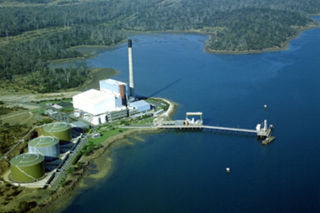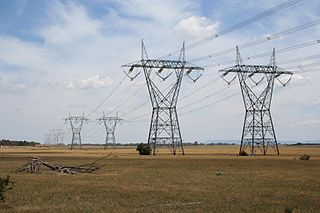The New Zealand electricity market (NZEM) is a decentralised electricity market regulated by the Electricity Industry Participation Code administered by the Electricity Authority (EA). The authority was established in November 2010 to replace the Electricity Commission.
Meridian Energy Limited is a New Zealand electricity generator and retailer. The company generates the largest proportion of New Zealand's electricity, generating 35 percent of the country's electricity in the year ending December 2014, and is the fourth largest retailer, with 14 percent of market share in terms of customers as of December 2015.

Hydro Tasmania, known for most of its history as the Hydro-Electric Commission (HEC) or The Hydro, is the trading name of the Hydro-Electric Corporation, a Tasmanian Government business enterprise which is the predominant electricity generator in the state of Tasmania, Australia. The Hydro was originally oriented towards hydro-electricity, due to Tasmania's dramatic topography and relatively high rainfall in the central and western parts of the state. Today Hydro Tasmania operates thirty hydro-electric and one gas power station, and is a joint owner in three wind farms.

Transend Networks Pty Ltd was a Tasmanian government-owned business which operated between 1998 and 2014 as the electricity transmission network provider for Tasmania, Australia. It was formed by the disaggregation of the Hydro-Electric Commission, and ceased operation when it was merged on 1 July 2014 with the distribution division of Aurora Energy to form the combined network business TasNetworks.

The Tasmanian Government or the Government of Tasmania is the executive branch of the Australian state of Tasmania. The leader of the party or coalition with the confidence of the House of Assembly, the lower house of the Parliament of Tasmania, is invited by the governor of Tasmania to form the executive. The governor appoints the premier of Tasmania.
The National Electricity Market (NEM) is an arrangement in Australia's electricity sector for the connection of the electricity transmission grids of the eastern and southern Australia states and territories to create a cross-state wholesale electricity market. The Australian Energy Market Commission develops and maintains the Australian National Electricity Rules (NER), which have the force of law in the states and territories participating in NEM. The Rules are enforced by the Australian Energy Regulator. The day-to-day management of NEM is performed by the Australian Energy Market Operator.
EnergyAustralia is an electricity generation, electricity and gas retailing private company in Australia. It is one of the "big three" retailers in the National Electricity Market. It generates electricity primarily using coal fired generation, at the Yallourn Power Station in Victoria, and the Mount Piper Power Station in New South Wales. 10% of its generation is from wind power, 32% from gas, and 58% from coal. It is Australia's second biggest emitter of greenhouse gases, after AGL Energy. As a loss making company in 2023, its parent in Hong Kong, CLP Group, has stated that it is looking for partners for renewable energy investment, however as of this time, there were no plans to build new renewable energy itself.

Manawa Energy limited is a New Zealand electricity generation company that offers bespoke electricity products to commercial and industrial customers across New Zealand. Manawa energy currently operate 26 power schemes from the Bay of Plenty in the north, to Otago in the south.

Energex is an Australian-based wholly Queensland Government owned electricity company distributing power to 1.5 million homes and businesses in South East Queensland. The boundaries of the company’s distribution area stretch from Coolangatta in the south to Gympie in the north and as far west as the foothills of the Toowoomba range.

Ergon Energy Network is a subsidiary company of Energy Queensland Limited (EQL) a Government owned corporation owned by the Government of Queensland. It distributes electricity to around 763,000 customers across Queensland, excluding South East Queensland through a distribution network regulated by the Australian Energy Regulator (AER) who set the prices that Ergon is allowed to charge for distribution.

Synergy is a corporation owned by the Government of Western Australia. Synergy is Western Australia’s largest energy retailer and generator with more than one million industrial, commercial and residential customers, generating total annual revenue of more than $3.2 billion.

Integral Energy was the second largest state-owned energy corporation in New South Wales, incorporated under the Energy Services Corporations Act 1995 from a merger between Prospect Electricity and Illawarra Electricity. Integral Energy was involved in electricity retail in addition to owning an electricity distribution network and previously held licences to retail electricity in the contestable markets covered by the NEM.

The Bell Bay Power Station was a power station located in Bell Bay, on the Tamar River, Tasmania, Australia, adjacent to the Tamar Valley Power Station, with which it was often confused. It was commissioned between 1971 and 1974 as an oil fired thermal power station, and was converted to natural gas in 2003, after the commissioning of the Tasmanian Gas Pipeline, a submarine gas pipeline which transports natural gas from Longford, Victoria, under Bass Strait, to Bell Bay, Tasmania. As the power station's primary role was to provide system security in the event of drought for Tasmania's predominantly hydro-electric based generation system it only was rarely called on to operate, resulting in intervals of five to eight years between periods of significant use. After the commissioning of Basslink in 2006, the power station was decommissioned in 2009.

Contact Energy Limited is a New Zealand electricity generator, a wholesaler of natural gas, and a retailer of electricity, natural gas, broadband and LPG.

Energy in Victoria, Australia is generated using a number of fuels or technologies, including coal, natural gas and renewable energy sources. Brown coal, historically, was the main primary energy source for the generation of electricity in the state, accounting for about 85% of electricity generation in 2008. The amount of coal-fired power has decreased significantly with the closure in 2017 of the Hazelwood power station which supplied around 20% of Victoria's electricity, and to a lesser extent with the exit of Anglesea power station in 2015. Brown coal is one of the largest contributors to Australia's total domestic greenhouse gas emissions and a source of controversy for the country. Australia is one of the highest polluters of greenhouse gas per capita in the world.
Tamar Valley Power Station is a $230 million natural gas-fired power station located in Bell Bay in the Tamar Valley, Tasmania. It is owned by Hydro Tasmania, and is immediately adjacent to the decommissioned Bell Bay Power Station, which is also owned by Hydro Tasmania.

Tasmanian Networks Pty Limited, trading as TasNetworks, is a Tasmanian Government State owned company that is responsible for electricity transmission and distribution throughout Tasmania. It also owns and operates a telecommunications network throughout the state.
The 2016 Tasmanian energy crisis was an ongoing energy storage situation in the state of Tasmania, Australia in 2016. Two years of high volumes of energy exported to Victoria via the Basslink HVDC cable, followed by low rainfall, and a fault which rendered the cable inoperable, resulted in record low storage levels in Tasmania's hydro-electric system. This resulted in a number of contingency plans to be enacted by Hydro Tasmania and the Hodgman Government.
Marinus Link is a proposed 750 megawatt capacity high voltage direct current (HVDC) electricity interconnector, to strengthen the connection between the Australian states of Tasmania and Victoria, on Australia's National Electricity Market. Due to inflation, Marinus link was scaled back from an initial plan of 1500 MW via two cables, down to 750 MW via one cable. It involves approximately 250 km of subsea cables and approximately 90 km of underground land cables. Marinus Link will also incorporate significant optical fibre capacity for system control, with the remaining capacity available to strengthen telecommunications and data connectivity between the regions. Marinus Link will be supported by approximately 220 km of high voltage alternating current (HVAC) of proposed transmission developments in North West Tasmania, known as the North West Transmission Developments (NWTD). Collectively, Marinus Link and the North West Transmission Developments are known as Project Marinus. In October 2022, authorities pledged loans for the project, as well as supporting facilities such as pumped hydro in Tasmania.
Tasmania, as an advanced economy with a globally high standard of living, uses a great deal of energy. Distinctive features of energy use in Tasmania include the high fraction of hydroelectricity usage, the absence of coal-fired electrical generation, relatively light usage of natural gas, particularly for domestic use, and a wide use of domestic wood-burning stoves. Energy production through hydroelectricity has been politically contentious, and conflicts over Tasmanian hydroelectric projects were integral to the formation of Green parties in Australia and across the world.












